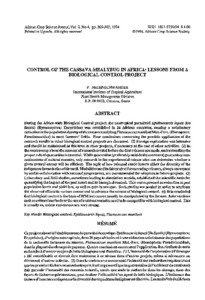| dc.contributor.author | Neuenschwander, P. |
| dc.date.accessioned | 2019-12-04T11:26:22Z |
| dc.date.available | 2019-12-04T11:26:22Z |
| dc.date.issued | 1994 |
| dc.identifier.citation | Neuenschwander, P. (1994). Control of the cassava mealybug in Africa: lessons from a biological control project. African Crop Science Journal, 2(4), 369-383. |
| dc.identifier.issn | 1021-9730 |
| dc.identifier.uri | https://hdl.handle.net/20.500.12478/4570 |
| dc.description.abstract | During the Africa-wide Biological Control project, the neotropical parasitoid Epidinocarsis lopezi (De Santis) (Hymenoptera: Encyrtidae) was established in 26 African countries, causing a satisfactory reduction in the population density of the cassava mealybug Phenacoccus manihoti Mat.-Ferr. (Homoptera: Pseudococcidae) in most farmers' lields. Four conclusions concerning the possible application of the research results to other biological control projects are discussed. (1) Foreign exploration was intensive and should be maintained at this level in other projects, if necessary at the cost of other activities. (2) In the controversy about the amount of research needed before the lirst releases are made, understanding the proper role of quarantine is essential. While quarantine (preferably outside the continent) guarantees nonnoxiousness of natural enemies, only research in the experimental release sites can determine whether a given natural enemy will ·be efficient. The topic of how released exotic insects affect the diversity of the indigenous fauna is also addressed. Modalities used in this project for executing releases, always on request by and in collaboration with national programmes, are recommended for adoption in future projects. (3) Laboratory and field studies, sometimes leading to simulation models, established the scientific basis for quantifying the impact of the pest insect and its biological control. This was expressed as reduction in pest population levels and yield loss, as well as gain in revenue. Such studies are needed in order to attribute the observed effects to various causes and to advance the science of biological control. ( 4) It is concluded that biological control is the basis ofiPM but cannot usually be manipulated by the farmer. Interventions such as cultural methods or the use of resistant varieties need to be compatible with biological control. This is usually so~ unless resistances are very strong. |
| dc.description.sponsorship | International Development Research Centre |
| dc.description.sponsorship | Deutsche Gesellschaft für Internationale Zusammenarbeit |
| dc.description.sponsorship | African Development Bank |
| dc.description.sponsorship | European Union |
| dc.description.sponsorship | International Fund for Agricultural Development |
| dc.description.sponsorship | United Nations Development Programme |
| dc.language.iso | en |
| dc.subject | Biological Control |
| dc.subject | Phenacoccus Manihoti |
| dc.subject | Cassava |
| dc.subject | Mealybugs |
| dc.title | Control of the cassava mealybug in Africa: lessons from a biological control project |
| dc.type | Journal Article |
| dc.description.version | Peer Review |
| cg.contributor.affiliation | International Institute of Tropical Agriculture |
| cg.coverage.region | Africa |
| cg.coverage.region | West Africa |
| cg.coverage.country | Benin |
| cg.authorship.types | CGIAR single centre |
| cg.iitasubject | Cassava |
| cg.iitasubject | Disease Control |
| cg.iitasubject | Pests Of Plants |
| cg.iitasubject | Plant Diseases |
| cg.accessibilitystatus | Limited Access |
| local.dspaceid | 100820 |

